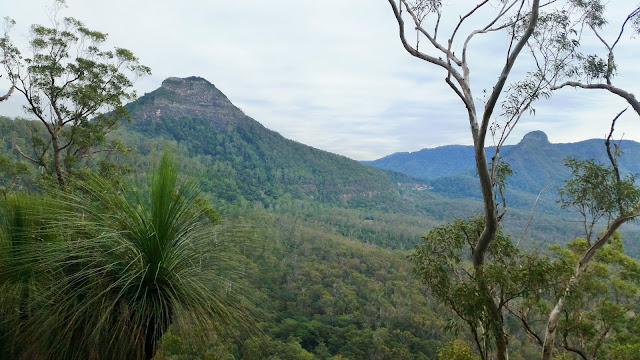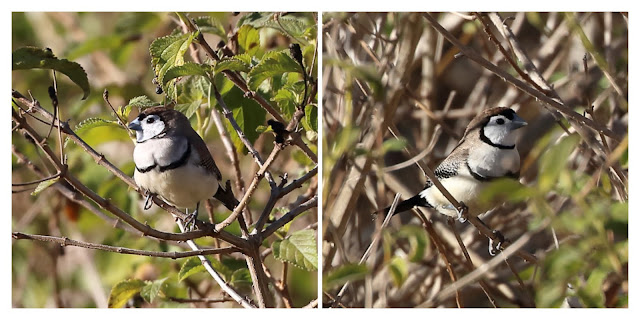 |
| Spicers Gap Camping Area |
We packed the tent in the ute and enjoyed a tranquil stay at
Spicers Gap Campground. During the early evening the sounds of heavy trucks
making their way up and down Cunninghams Gap drift up the range, yet this the campground has a remote feel and during the week is quite often empty.
Another thing that seems incongruous is that, despite being in a national park,
the campground is opposite a small mango farm. No doubt there is an interesting
back story as to how this came about.
 |
| Mango farm (L), Spicers Gap Camping Area (R). |
Day Use
Area
The Day Use Area adjoins the campground and shares the only amenities block. There are three picnic tables with fireplaces which can also be used by day trippers or campers.
 |
| Picnic facilities. |
Pioneer
Graves Track: 260 m, Class 2.
There is an historical graveyard only a short walk from the Day
Use Area. There are no headstones, only a cairn in memory of the dead.
 |
| Spicers Gap memorial cairn. |
Mount
Mathieson Trail, 8.1 km.
 |
| View on the way up. |
In the early morning, we crossed Spicers Gap Road to the start of
the trail head. The first section is dominated by the constant calls of Bell
Miners. Then we entered lush, cool rainforest. We saw Green Catbirds calling
out in the open. The track climbs steadily until it reaches an area with
excellent views over the Cunningham Highway. We had a good vantage point right
above the emergency escape ramp for vehicles that lose their breaks.
Thankfully, there were no emergencies while we watched on.
 |
| Views of the Cunningham Highway from Mount Mathieson. |
 |
| Magnificent views on the Mount Mathieson Trail |
We continued on for a short distance and came to a sign stating
that the Mount Mathieson Trail is “ungraded”. Having read on the official
national parks internet site that the Mount Mathieson Trail is a Class 4 trail
we weren’t too worried and continued on. Before long the track deteriorated and
at one point we spent some time carefully deciding just where the track
continued forward. We didn’t want to get lost and we certainly didn’t want to
accidentally fall off a cliff and end up using the helipad on Cunninghams Gap! About
this time, we checked that, yes, we did have our Personal Locator Beacon. The
next challenge was a mercifully short but very steep section. We began to regret carrying so much camera gear and we started to hope that the
trail wasn’t going to get any worse because we didn’t fancy trying to return
back down the way we had just come!
 |
| Some of the steeper section of the "trail". |
We proceeded along a ridge line with more magnificent views and before
long the trail became an easy descent through rainforest.
We crossed open balds where we saw Swamp Wallabies bounding away from us and open grasslands with large tracts of non-native Hairy Balls milkweed.
 |
| Milkweed Gomphocarpus physcocarpus is an important plant for Monarch Danaus plexippus caterpillars. |
1.7 km after Mount Matheison and 1.1 km before the Mount Mathieson car park, is the remains of an old timber jinker.
 |
| Front half of an old timber jinker. |
About 100 m before we reached the Mount Mathieson car park we
startled two wild pigs. One, a large sow, stopped and
turned back towards us and it looked like she was considering charging back at
us. This had me worried that perhaps we had inadvertently placed ourselves
between a mother and her piglets. After a tense moment, while we held our
breath and looked around for the nearest climbable tree, she turned around and
hurtled away from us.
The Mount Mathieson car park is at the top end of the 4WD road
that starts at Cunninghams Gap. Between this car park and the car park at
Governors Chair is a pleasant, 1.6 km, Heritage Trail, which forms part of the
Mount Mathieson Trail. The trail has informative signs along it explaining the
history of the area.
 |
| Entering the Heritage Trail from the Mount Mathieson car park. |
From the Governors Chair car park we walked 150 m to the Governors
Chair Lookout. We sat on the “chair” and enjoyed a snack with magnificent views over Moogerah Peaks National Park, despite it being an overcast day. Caution: there is a sheer drop at the lookout and no fences.
 |
| Governors Chair Lookout. |
We walked the final 2 km of the trail by descending to the campground
along Spicers Gap Road. We did a quick detour of 120 m (return) to Moss’s Well on
the way. The well had seen better days but a Grey Fantail seemed to be guarding over it.
 |
| Moss's Well. |
We didn’t see a single person on the walk. The only people we saw
all day were a couple that drove up to Governors Chair Lookout Car Park while
we were there.
If you are not an experienced hiker, I would recommend doing the
Mount Mathieson Trail in two sections. One section, which requires some
fitness, would be to start walking the trail opposite the Day Use Area and
climb until you reach an area with interesting views and return the way you
came. The second section would be to drive to the parking area at Governors
Chair and do the Heritage Trail. At the end of the Heritage Trail either return
to the Governors Chair parking area or walk along the Mount Mathieson Trail for
any distance that feels comfortable before returning the way you came.
The following day we packed up and did a short section of the
Mathieson Trail before leaving. It wasn’t until we downloaded our photos that
we discovered that during the whole camping trip, including our walk of the
Mount Mathieson Trail, the lens stabilization switch on our zoom camera lens
had accidentally been switched off. Unfortunately, all of our bird photos were unusable as they were decidedly on the blurry side.
Details
for Spicers Gap Camping Area, Main Range National Park:
 |
| Spicers Gap Road |
Access: Spicers
Gap Campground is about 105 km west of Brisbane, off the Cunningham Highway.
Continue past Aratula for 5 km then turn left into Lake Moogerah Road. After
about 6 km turn into Spicers Gap Road which is a 2WD unsealed road and continue
for 3.3 km to the campground and Day Use Area. The national park section of
Spicers Gap road is very narrow and not suitable for caravans, buses and large
motorhomes. It is a further 2 km to Governors Chair carpark. The road to
Governors Chair car park is listed as 2WD, however, it is quite steep. The road
stops at the car park and it is not possible to drive through the range to the high-clearance,
dry weather only, 4WD road on the other side of Spicers Gap which stops at the
Mount Mathieson car park. It is a pleasant 1.6 km walk along the Heritage Trail
between the two car parks.
Type of
Camping: tent camping on open grassy areas separated from your vehicle by
bollards.
Number of
Sites: undefined sites, maximum of 50 people.
Facilities: There is
one male and one female composting toilet shared between the campground and the
Day Use Area. There is one tap of non-potable water near the amenities block. There
are no fire rings, however, elevated BBQ’s and braziers are allowed. There are
three picnic tables with wood BBQ’s positioned between the camping and picnic areas.
We had good Telstra mobile phone reception. Walks. No bins. No showers.
Prohibitions: No
generators, no fires on the ground, no wood collection from the park or the
side of the road, no amplified music, no domestic pets and no firearms.
Fees: $5.95
per person, children under 5 years are free. There is a Family Rate of $23.80
for 1 to 2 adults with children under the age of 18, with a maximum of 8 people
in total.
Bookings: Phone 13 74 68 or
online at http://parks.nprsr.qld.gov.au/permits. Limited phone reception. We
had Telstra mobile phone reception.
Bird List
for this trip:
Wompoo Fruit Dove, Wonga Pigeon, Yellow-tailed Black Cockatoo,
Sulphur-crested Cockatoo, Australian King Parrot, Crimson Rosella, Laughing
Kookaburra, White-throated Treecreeper, Variegated Fairy-wren, Yellow-throated
Scrubwren, Bell Miner, Noisy Miner, Lewin's Honeyeater, Yellow-faced
Honeyeater, Eastern Whipbird, Eastern Yellow Robin, Little Shrike-thrush, Grey
Shrike-thrush, Golden Whistler, Rufous Whistler, Grey Fantail, Willie Wagtail,
Green Catbird, Satin Bowerbird, Grey Butcherbird, Pied Currawong, Torresian
Crow, Red-browed Finch.














